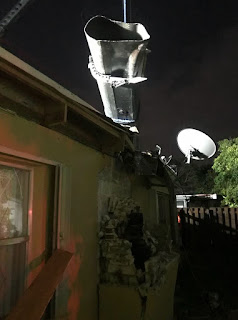CAPE CORAL, FLORIDA
A Southwest Utility Systems worker died Friday afternoon while installing a new water and sewer line beneath a manhole in northwest Cape Coral.
The name of the man had not been released Friday afternoon.
About a dozen of the man’s family and friends gathered at what was believed to be a construction accident. Two women could be seen sobbing about 20 feet from where the man died as paramedics spent almost two hours working to recover his body, which had been submerged under water, according to a witness.
“He was a great guy,” said a man who wouldn't give his name but acknowledged he knew the dead man. “That’s all you need to write. Short and simple. He didn’t have a bad bone in his body.”
Just before noon, Paula and Derek Rabe were working from their home, just north of Mariner High School and Tropicana Parkway on the 800 block of Northwest 13th Avenue, when a utilities worker had knocked on their door.
“It took me a little time to get up and go to the door,” Paula Rabe said. “I walked out, and he was standing by his truck, and I said, ‘Can I help you?’ He said his friend had passed out. I went and got my phone and called 911. I looked down and saw he was underwater.”
Southwest Utilities declined to comment. It took an hour and 45 minutes from the noon 911 call until paramedics removed the body from the hole at the foot of the Rabe’s driveway and into an ambulance. The paramedics covered the man’s body and walked slowly with the stretcher before loading it.
Fire trucks from South Trail, Iona McGregor and Cape Coral responded to the scene, where rain sprinkled as paramedics and firefighters recovered the body.
Rabe said the more she thought about it, the more she was convinced the man had died before she even called for help.
Cape Coral Police spokesman Dana Coston, who arrived to the scene after the body had been moved, said he was not sure whether the man had fallen into the hole or had suffered a medical problem while in the hole. But Rabe said she was almost certain the man had been in the hole – meaning he did not fall – and passed out because of a lack of oxygen.
“The things that come to my mind is that he was down there and had a heart attack or that he passed out from the lack of oxygen and he passed out from that,” said Rabe, who is a registered nurse. Once he quit breathing, he must have fell under the water, she said.
“He was definitely under the water," she said. "In those situations without oxygen, your body just shuts down.”
While waiting for paradmedics, Derek Rabe attempted to get the man above water with the end of a broom, but the broom couldn’t reach him, Paula Rabe said.
“Shortly thereafter, a bunch of construction workers pulled up,” she said. “They were trying to pull him out. Then the police came and the fire truck came. I think they were able to quickly ascertain that he had passed.
“Luckily, I haven’t dealt with much death in my nursing career, but it’s still traumatic.”
A number of family members of the man, including his son-in-law and two nephews, declined to comment, saying they needed time to grieve.
=====================
CAPE CORAL, Fla. -
A utility worker died Friday along NE 13th Avenue in Cape Coral.
The man was working in a manhole when he became unconscious, according to a report.
It is unclear at this time if the man died as a result of a work-related accident or if it was due to medical reasons.
The worker is an employee of the Utility Extension Project contractors in Cape Coral and is not a city contract employee.
OSHA is currently investigating.
Residents in the area should expect to see police and EMS on the scene for the next several hours.
No further information has been provided at this time.
======================
Cape residents concerned over speeding near utilities project
The Utilities Expansion Project in northern Cape Coral is raising safety concerns among residents as drivers speed down dirt roads.
Residents who live near the intersection of Northwest 3rd Terrace and Northwest 7th Avenue are frustrated and said nothing is being done to prevent drivers from exceeding the speed limit.
“People that cut through this part of Cape Coral, they don’t believe in following the speed signs at all,” resident John Black said.
The Cape Coral Police Department said they’re aware of the construction zones and are patrolling the area.
Crews are digging up roads to install water, sewer and irrigation lines — the goal is to eventually hook up homes to the city’s utilities.
Residents said speeding cars are only adding to the mess.
“A lot of dust is kicked up, but that’s pretty typical for a construction area. You see mainly sand and dust,” resident Heaven Grinsell said.
Police advise drivers that speeding through work zones will result in an increased fine.
The construction will continue into 2019.





























